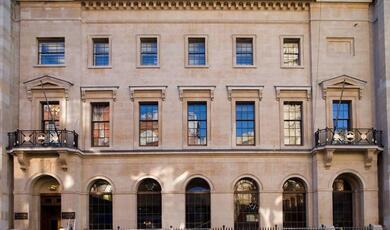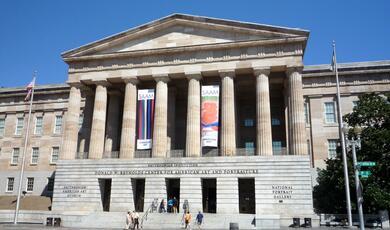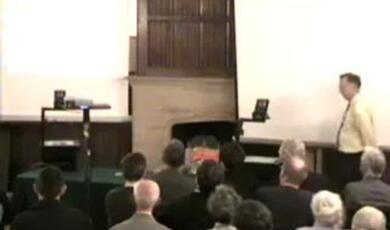On Top of the World, 1830 to 1914
Share
- Details
- Transcript
- Audio
- Downloads
- Extra Reading
Economic dominance brings cultural dominance and the architecture of Empire was, in part, a template for the world. But as the century turned there were already signs of big changes which were to go on to shape the England we now live in.
This is a part of the lecture series From Architectural Periphery to the World's Engine House: English Building from the Reformation to the First World War.
In this lecture series Simon Thurley continues his investigation into the history of building in England. Starting with the shattering events of the Suppression of the Monasteries and the Civil War he moves on to look at the architectural consensus that briefly reigned in the mid eighteenth century before it dissolved in the white heat of the Industrial Revolution. Economic and technological change then drove English building in remarkable new directions for over 150 years. This period was ended by another shattering event, but this time of global proportions – the First World War. This extraordinary chronicle is not just history of architecture, but the history of an ascendant civilization.
The other lectures in this series include the following:
The End of the Old World Order, 1530-1650
The Rise if Consensus, 1650-1760
Engine House, 1760-1830
Download Transcript
7 March 2012
On Top of the World
1830 - 1914
Professor Simon Thurley
Tonight we turn to the nineteenth century. What a vast subject, what a broad canvass, how to make sense of an age when so much was built and so much architectural diversity created. Well, somehow I will have to, and that’s why, of course, I’m standing here. However Gresham College have made my job quite a lot easier as, since my last lecture, I have been invited to continue my visiting professorship for another year. So this allows me a bit of headroom. Despite its advertised title I have decided to make tonight’s lecture, which deals with the period 1830 to 1914, part one of two. In October I will deliver 1830 to 1914 part II which will deal with Victorian cities and their infrastructure. Tonight I’m going to address the issue of architectural style in Victorian England.
The complexity of explaining and understanding English architecture after 1760 derives essentially from three things. These are not in any order or causal juxtaposition: the first is, changing demands - new types of building for new types of activity: railway stations, post offices, law courts, factories, warehouses, pumping stations for example. The second is rapidly developing technology in materials and techniques: iron, steel, glass, terracotta etc. The third is historicism, the fact that there were many styles to choose from, everything from Egyptian and Hindu to Ottoman and Elizabethan. Tonight I’m going to start with the third of my three factors, historicism, for it is this that most neatly links with what I said in my lecture in February.
From the Middle Ages architecture was always a response to what was seen to be an appropriate form. It was built with the appropriate degree of elaboration, of scale, of presence in the landscape. But from the civil war a greater divide grew up between buildings designed in traditional gothic styles (for want of a better word) and those which were more closely imitating classical forms. Churches, colleges and some royal and Episcopal buildings were usually built in gothic styles while public buildings, urban dwellings and country houses were normally built in classical styles. During the eighteenth century classical buildings were increasingly scrutinised for their faithfulness to precedent and for a brief while during the 1740s and 50s there was a broad consensus that the most fashionable buildings were to be measured against a rule of taste governed by published classical examples.
During the late eighteenth century three things begin to break up this consensus. The first is the idea of architecture as scenery, as part of a landscape, we call it the picturesque aesthetic; the second is the increased value put on associationist aesthetics and the third is the rise of archaeology.
From the 1720s gardens contained buildings which were designed to be associational, emblematic of a period or an emotion that the owner wanted to communicate. Amongst the earliest was Chiswick House that was dotted with pavilions and temples that were intended to reinforce the idea that these were the gardens of an ancient Roman senator and not just an 18th century aristocrat. This idea was described in the mid eighteenth century and in the late 1760s and 70s, at Shugborough House in Staffordshire, there was a Chinese summer house, a pagoda and bridges, a Palladian bridge, a Greek temple, a Grecian tower of the winds, a Hadrianic arch, a shepherd’s house, a gothic pigeon house and assorted ruins. They were built for Admiral George Anson who had spent three years sailing the world. On his retirement the world came to him in his own gardens. These buildings, by association illustrated the great man’s achievements and life.
The effect of this was that the idea of an objective standard of beauty was abandoned. No longer was there a single classical ideal. All these landscapes were beautiful and they mixed and matched buildings from every conceivable architectural style. Access to these new styles was hugely boosted by developments in archaeology. Archaeology had started at home with an increased interest in the ruins of medieval England from around 1700. Travel by road, which we discussed in my last lecture, had enabled people to perambulate the country much more easily. The great ruins were the products of the Reformation and for some the still within memory civil wars. Looking on buildings detonated by the previous generation aroused romantic notions. These were bolstered by histories of counties, towns, families and of great buildings. From 1711 Samuel and Nathaniel Buck started producing their prints of castles abbeys and towns which were eventually to amount to more than 400 views. Travelling through England became not just a journey through the countryside but one through history[i].
But these travels went further afield and from the 1750s there was a deluge of books published by architects and antiquarians illustrating accurately the ruins of the world. The Ruins of Palmyra was published in 1753, The Ruins of Baalbec in 1757, Designs of Chinese buildings was also published in 1757, the first volume of The Antiquities of Athens in 1763 and the ruins of the Emperor Diocletian’s Palace at Split in 1764. This meant that not only was there desire to build exotic structures but the information as to how to build them was available.
So what were the practical effects of all this? Well let’s look at three buildings, all broadly contemporary: Fonthill Abbey by James Wyatt (1795-1812) in megalomaniac gothic, Brighton Pavilion by John Nash (1815-21) in European Hindu and The British Museum by Robert Smirke (1823-47) in academic Greek. It might be tempting to categorise the three architects who designed these on the stylistic basis of these commissions, but I could have equally well chosen John Nash’s Ravenworth Castle, County Durham begun in 1807 and only finally completed in 1846. This was in a medieval castellated style (dem.1953). Or Robert Smirke’s County Court in Lincoln Castle built in 1823-30 in a slightly different medieval style to blend in with the medieval architecture of the castle. Or James Wyatt’s earlier Darnley mausoleumat Cobham Hall Kent which was crowned by a pyramid. You see my point is that during the period 1760 until around 1850 to be a successful architect you needed to be able to turn your hand to a multitude of distinct styles.
I introduced today’s lecture by saying that there were three things that changed the face of architecture in England after 1760. The first as I have just described was historicism, the massive multiplication of fashionable styles to choose from. The second was technology and in this the most important factor was the increasing use of iron and steel.
The crucial thing to understand about the introduction of iron is that it was not primarily promoted by architects. It was the manufacturers and the craftsmen who promoted its use. Last time I described its earliest uses – Iron bridge in Coalbrookdale and the columns in the House of Commons. Both of these uses were promoted by manufacturers, in the case of the House of Commons by Jean Tijou the royal smith eager to promote the use of his material.
In fact the House of Commons became typical of the earliest use of exposed iron in interiors, as it was recognised as a way of building slender supports in auditoria creating good sightlines. In ironworking districts iron columns began to be used to support church galleries: at St. Chad’s Church in Shrewsbury in 1792-4 the architect George Steuart built iron columns that supported the gallery and then ran through it to support the wide span roof above. But the most influential early building was in London, the Theatre Royal Drury Lane as remodelled by Henry Holland in 1791-4. Here iron held up tiers of boxes but also provided fireproofing between floors. Rolled sheets of wrought iron were laid between the timber joists and the floorboards as a fireproof barrier.
This concern with fire is what we saw last time with the construction of the world’s first iron-framed building at Ditherington just outside Shrewsbury. But architects also began to adopt iron because of the decorative effects it could achieve and for the structural support it could give. We have already mentioned the Royal pavilion in Brighton, here John Nash used iron decoratively to make the bamboo staircases, which were in fact all iron; for the hugely tall columns supporting the kitchen roof decorated with copper leaves and for the structure of the great dome.
The successful use of iron beams had a huge impact on architectural design. The plans of upper floors no longer needed to reflect those beneath. The bedroom floors of country houses could have a maze of small rooms built in brick over large state spaces beneath. Shops could be built with large floor plates and rooms on a tighter plan above. But the turning point was the 1851 Great Exhibition and the crystal palace.
Glasshouses were common in England from the 1680s, most often in the form of orangeries, but increasingly in the form of glasshouses. After 1805 commercial glasshouse owners began to experiment with the replacement of timber members with iron, for cheapness of construction and ease of maintenance. Perhaps the most exotic glass house ever made was the conservatory erected at Carlton House, London, for the Prince Regent in 1807 to the design of Thomas Hopper. This gothic confection was entirely of cast iron, a joy to walk in perhaps, but useless as a place to grow things.
The step forward for horticulturalists came in 1815 when George Mackenzie showed how curved glazed surfaces would let in better light. A young agricultural improver, J. C. Loudin, and an ironmaster William Bailey, of W & D Bailey, invented a curved wrought iron bar that could be used in hothouses. Bailey started manufacturing large numbers of new curvilinear hot houses. An early surviving example probably made using the Loudon and Bailey bar is the wonderfully bulbous Palm House at Bicton Park, Devon built in c.1825. But the hothouse that sparked a revolution was the Palm House at Kew gardens built in 1846-8. The innovations in this remarkable building were again down to engineering manufacturers, principally Richard Turner of Dublin who worked with the architect Decimus Burton on the design.
The Crystal Palace was one direct successor of these buildings. It was not only important in terms of its structure it was perhaps for the first time in architectural history a structure that instantly enjoyed world-wide fame; a structure that advertised on a global scale, the uses to which iron could be put. The Crystal Palace was created, like the railways, by a group of designers. The man who came up with the crucial problem-solving idea was Joseph Paxton first a horticulturalist but also engineer, railway director and promoter of newspapers. But Paxton shares the credit for the building with Charles Fox one of the pre-eminent railway designers of the age who had cut his teeth under George Stephenson at Euston Station and Charles Barry, already a leading proponent of the use of iron in architecture. Others were involved too including Matthew Digby Wyatt and Owen Jones, architects responsible for embellishing the building’s interior.Thus it was a modern building in the sense that it was constructed by a team of designers.
Crystal palace might have seemed to be the model for Victorian architecture, the end of the stylistic chaos that prevailed: but the building was erected for an ephemeral purpose and all architecture of any scale before had been erected with the idea of solidity and permanence. For this reason and for many others Crystal Palace was not regarded as architecture by architects. They thought architecture began where engineering ended. What Crystal palace did was not unite technology and architecture but expose the gulf between them.
So what were the aspirations of architects before the 1851 Great Exhibition? We have seen that in the eighteenth century what we know as classical architecture became the style of choice for public buildings, town houses and most country mansions. These buildings were essentially inspired by printed materials, the books of Scamozzi and Palladio and were supplemented by prints descriptions and for the lucky first hand travel. From the 1730s there were concerted attempts to design buildings that were archeologically accurate reproductions of ancient buildings uncorrupted by the work of renaissance architects. So Lord Burlington’s Assembly Rooms at York, which we looked at two times ago, were a scholarly and careful essay in trying to build a genuinely accurate Classical building.
Before the 1750s architects such as Robert Adam were deliberately basing their architecture on closely recorded examples from Ancient Rome and Greece rather than Renaissance examples transmitted by print. As I have explained archaeology had laid out wonderful architectural components in Spalato, Herculaneum, Pompeii, Palmyra and Baalbeck. What Adam did was take these and combine them in his own personal way. So, as an example, let’s look at what is perhaps Adam’s finest interior, the Ante-Room at Syon House, Middlesex, built in 1761-5. The gilded volutes of the ionic columns are taken straight from the Erechtheion porch on the Acropolis in Athens, but the necking of the capitals is taken from an example illustrated in Cameron’s Baths of the Romans. The actual necking is used by Adam as the frieze of the entablature. So you see Adam was very archaeological in his approach, but free with his composition creating buildings that were in his own style.
There were others who followed in this mode, all rivals for patronage emphasising their individuality, but working from the same premise. James Stuart, often known as Athenian Stuart’s finest work is the interior of the chapel royal at the Royal Hospital Greenwich of 1789. The pulpit was modelled on the monument to Lysicrates in Athens. James Wyatt, was responsible for the Radcliffe Observatory in Oxford finished in 1794, another handsome essay in the deployment of Greek architecture, but this time the temple of the Winds.
These essays in classical architecture became more and more archaeologically correct and after 1810 the rage was for buildings closely modelled on Ancient Greek examples. There were many of these, one of my personal favourites is the extraordinary Belsay Hall, completed in 1817, an attempt by its owner Sir Charles Monck to reproduce in Northumberland a Greek house based on his own personal observations in Greece over the previous three years. In London perhaps the most prominent was the The British Museum by Robert Smirke (1823-47). Smirke had also travelled through Sicily and Greece and had gained a profound knowledge of Greek architecture, this was applied to the new museum which rose as a sort of temple to world civilizations.
It was public buildings that were deemed most appropriate for this classical treatment and they culminated in the single most remarkable classical building of the whole nineteenth century, St. George’s Hall Liverpool. It was designed by Harvey Lonsdale Elmes and opened in 1854. It was a response to the extraordinary wealth and expansion of Liverpool as a port. In my last lecture I referred to its docks and showed you both these views. I commented on the cast iron portico of the dock house. This was commercial ambition, but St. Georges Hall was megalomaniac civic ambition. Elmes’s brief was quite literally to be the biggest civic building in England. It was stressed, in particular, that it had to be larger than Birmingham’s town hall. And a plan of St. Paul’s cathedral was superimposed over it just to show that the hall would be bigger. The guts of the design were Greek, but lots of Roman details were used too. The interior of the Hall had the logo SPQL stamped all over it - a variant on the Roman SPQR – the senate and people of Rome. Elmes had deep archaeological knowledge and applied it with confidence.
But I don’t want us to forget my original premise which is that one of the underlying issues for Victorian architects was rapidly changing technology. For St. George’s hall was one of the most technologically advanced building’s of its age. In fact it was the first building in the world to be properly air-conditioned. The unique system was designed by Dr David Boswell Reid of Edinburgh. Reid had designed a very successful ventilation system for the temporary House of Commons erected in 1835 following the previous year’s fire. This cross section is from Boswell’s instruction manual handed over to the city on 1855 and shows the brilliant air circulation through the building from the basement and up through the roof keeping it’s interiors temperate all the year round. In just the same way the construction of the British Museum involved the use of cutting-edge technology, the whole building was constructed on a grid of cast iron beams disguised by timber and plaster as architectural members. The beams of the King’s library spanned a huge 41 feet and had a special flanged section to support a ceiling of arched iron plates to improve on fire safety.
But just as classical architecture was becoming more archaeologically correct so was the gothic. Augustus Welby Northmore Pugin condemned the gothic being built by architects like James Wyatt. He hated the glib use of ecclesiastical details on secular buildings – see Fonthill Abbey, William Beckford’s colossal gothic country house designed by Wyatt. You kind of get Pugin’s point when you look at this! He also hated the use of gothic as a decorative rather than a structural system. He believed that architects should decorate their construction not construct their decoration. Pugin’s best and most successful building is St. Giles’s Church Cheadle, Satffordshire where we can see the programme set out – the desire to erect archaeologically correct medieval churches. But Pugin was a Roman Catholic and it was left to the Cambridge Camden Society, a group of Anglican clergymen and academics, to transform England’s parish churches. After 1846 they were known as the Ecclesiological Society and they promoted Pugin’s architecture, but Anglican theology. A typical Ecclesiological church from 1848-51 is Holy Innocents, Highnam, Gloucestershire by Henry Woodyer where the church, vicarage and school were built by the local ecclesiologically minded squire.
Huge numbers of new churches were built, in fact between 1830 and 1860 1,500 new churches were erected in England – I will return to the reasons for this in my next lecture, but for now I want to emphasise that the majority of these were built in gothic styles. At first what is most often known as the English decorated style – that is to say architecture from the late thirteenth and early fourteenth century.
So up to the 1850s we see an extraordinary mix of styles with variants of classical and gothic architecture most to the fore. While public buildings were generally built in archaeologically correct classicism there was now a vigorous church building movement in correct gothic. But, architects asked, where was the style of their own? What was the style for the nineteenth century. How could it be that this nation with all its wealth and innovation, its technology and its industry, a society that was pushing the boundaries of how people lived could only copy the styles of other civilizations that had come before? This was the great architectural dilemma of the century and one which started to find and answer after 1850.
But you see the real dilemma was not gothic versus classical it was, as I have already intimated, really about architecture versus engineering. For most architects during the 1830s, 40s and 50s whether of a classical or a gothic persuasion architecture was in fact archaeology. While the architects minutely studied the proportions of buildings 6,000 years old, engineers were creating a new world with new materials.
But the Victorians did succeed in inventing their own style, only they didn’t recognise it. The years around the Great Exhibition saw a series of big changes in the context in which architects built. First of all a series of restrictions were lifted - glass duty was repealed in 1845, brick duty in 1850, window tax in 1851, as a result new possibilities were offered - brick buildings with big plate glass windows. Then there were the depressing effects of industrialisation, in particular the blackening smog of Victorian cities which led to a desire for something brighter and more colourful than the severity of smoke-stained stone. Thirdly there were new ideas, in particular those of John Ruskin, the architectural critic, traveller and sketcher who urged the use of northern Italian gothic through two brilliantly and persuasively written books, the Seven Lamps of Architecture (1849) and The Stones of Venice (1851-3).
A product of these changes was All Saints Margaret Street in London designed by William Butterfield in 1850 and completed three years later. It was deliberately designed to be a model for a new type of church by the Ecclesiological Society. But the big innovation was the use of brick, a material long out of use in London for churches. Butterfield used red and black brick with bands of stone and black brick to give the building a permanent colouring. Inside the polychrome was even richer, the arcade was treated like marquetry with marble and tiles and in the chancel onyx and gilding.
Another advocate for a change in style was G. E. Street the architect of the Law Courts in the Strand, the greatest national monument to be built in the gothic style. Designing this colossal building literally killed him and it was finished by his son. Yet it represents the pinnacle of a change in architecture that comes about after 1850. But I think the Law Courts are a bit of a mess, beautiful in individual sections and elements, but as a whole the thing lacks coherence. Yet what the Law Courts show is the direction in which architectural design went. For in a single building there were varieties of gothic from England, from France and from Italy. Architects had broken away from their archaeological obsession and were using gothic architecture as a free style. Creativity, originality and imagination were at the heart of what is often called high Victorian Architecture.
This high Victorian phase was transmitted easily to commercial and industrial structures. The Welsh Back Granary in Bristol by Ponton and Gough of 1869-70 is perhaps the most spectacular example of a style that came to dominate the industrial heartlands. This colossal grain warehouse, ten storeys high though clothed in venetian gothic clothing – as if a megalomaniac doge had commissioned it, was, in fact, a very high tech building. Of brick, iron, timber and concrete it had hydraulic lifts in each corner feeding sliding containers which poured wheat through multicoloured portholes. An office block like 73 Princess Street Manchester (1863) responded equally well to the style, as did a factory like the Lavers and Barraud stain glass works at Endall Street Covent garden of 1859.
I find this fascinating, these buildings, which as I said in my introduction, were constructed for a new purpose; they were constructed with the latest engineering and yet they were clothed in a retrospective style. This overwhelming sense of history which was their mainspring is, of course a reaction against industrialisation.
Industrialisation before 1830, which I dwelt on at length last time, was received with wonder, awe and pride. It was gentle, organic and brought prosperity everywhere. But by the 1850s it was grim, dirty, and ugly. Poverty, misery, pollution and disfigurement were everywhere. This, as I shall show in my next lecture was a challenge on almost every front. The merchants and factory owners were a new class of individual, people whose huge wealth was built on industrial processes networked into a global trading web. For them, as much as their architects, the question was in what style shall I build?
Northern Italian Gothic, and indeed Italian renaissance styles had a strong lure. They could see themselves in the traders, merchants and bankers of the northern Italian city states in the fifteenth and sixteenth centuries. Venice, a great trading state built on sea routes and power was a perfect fit for an image of themselves. So from the 1840s first Renaissance palazzo styles were used and then in the 1850s medieval Venetian ones. The first of these was 36 Charlotte Street Manchester built in 1839 and from then until 1880 this colourful brick style dominated commercial Manchester and the industrial midlands and north.
In the 1860s these primitive Italian gothic forms were increasingly taken up and mixed with other gothic styles, as we have already seen in the Law Courts. There were a number of very brilliant architects who succeeded in mastering a natural freestyle gothic. William Butterfield, who we have already met at All Saints Margeret Street was one of these, so was Alfred Waterhouse. Waterhouse’s buildings were based on the capabilities of an iron framed substructure. But the architecture that it supported was a brilliantly eclectic synthesis of styles and motifs. The London natural History Museum is one of the greatest. This is the entrance hall; a supposedly gothic building but containing a baroque imperial staircase and roofed with the technology of the great railway train sheds. But his greatest achievement, and possibly the greatest of all Victorian buildings, was Manchester Town hall built between 1867 and 1877.
The genius of this place lies in the fact that it was a thoroughly modern building, ingeniously planned and remarkably today still fit for purpose. The offices are on the outside getting the best light. The civic rooms are on the front facing Albert Square and each functional section has its own entrance. A pair of grand staircases link the levels and in the centre is the grand civic hall. When you look at its external elevations you are tempted to characterise it as a gothic building, but before you can you are overwhelmed by a plethora of other styles. I think that this is a building that you can simply characterise as Victorian.
The eclectic nature of buildings like Manchester Town Hall really characterises what you see in the 1860s. Classical architecture was absorbed by the gothic and no stylistic term other than Victorian will really do to describe them. Let me give you two examples. My first is in modern Stoke on Trent. It is the Wedgewood memorial Institute a design that combines Venetian Gothic with Georgian shaped windows, classical reliefs and renaissance roundels. My second example is the Langham Hotel opposite Broadcasting House here in London of 1864-6. Astonishingly this building is half gothic half classical. But it is successful and distinctive, a new style for a new age.
But that new age was the world’s age, because Britain was exporting its technology, its goods, its beliefs and ideas all over the globe. In their wake came its architecture. Still on English soil, though, was The Imperial Institute of the United Kingdom, the Colonies and India designed by T. E. Colcutt and built in 1887-93. Its mission was the dissemination of knowledge and its architecture was a fusion of everything so far known to man. Here you could find, gothic, Georgian, Francois premier, quattrocento, Spanish renaissance, Byzantine, Tudor, Norman and more. But this was not a jumble sale of eclectic motifs it was a genuinely synthetic building. Though it had its contemporary critics it was recognised that Colcutt had successfully synthesised the architecture of the ages to create a new style for the world.
Tonight we have seen how the classical consensus of the mid eighteenth century was shattered by archaeology, technology and historicism leaving a free for all in which architects despaired of having a Victorian style. There are many ways of presenting their dilemma: the future versus the past, architects versus engineers, traditional versus new construction techniques, architecture as a service versus architecture as art. Yet we mustn’t see art and science, architecture and engineering as opposites, for in reality they were inextricably entwined and the style that was so eagerly sought by the Victorians was, in fact, eventually discovered. It was that extraordinary fusion of historicism and engineering that produced buildings like the Imperial Institute and Manchester Town Hall.
But tonight we have been talking about the best and the most brilliant. In the hands of lesser men the jumble of ideas and styles produced something rather different and as they did industrialisation and urbanisation created problems that had architectural solutions. So I hope you can join me in October for part II of my look at Victorian Britain, when I turn to the problems of urbanisation and how the Victorians solved them. See you then.
© Professor Simon Thurley 2012
[i]C. Ridgway, ‘Rethinking the Picturesque’, C. Ridgeway and R. Williams ed., Sir John Vanbrugh and Landscape Architecture in Baroque England 1690-1730, (Stroud, 2000), pp.172-191
This event was on Wed, 07 Mar 2012
Support Gresham
Gresham College has offered an outstanding education to the public free of charge for over 400 years. Today, Gresham plays an important role in fostering a love of learning and a greater understanding of ourselves and the world around us. Your donation will help to widen our reach and to broaden our audience, allowing more people to benefit from a high-quality education from some of the brightest minds.


 Login
Login







